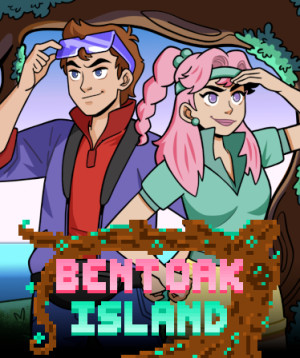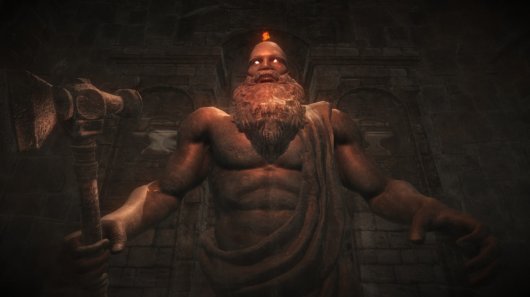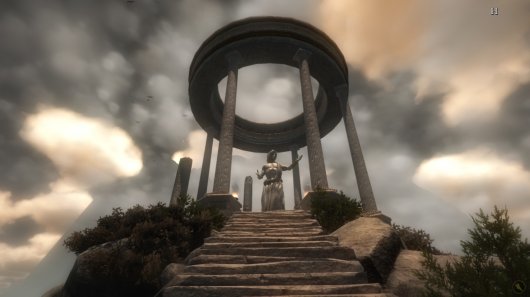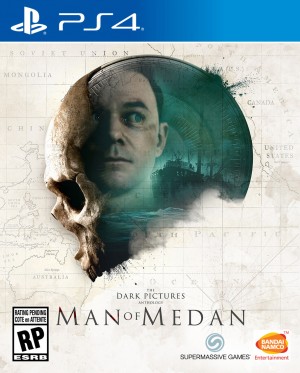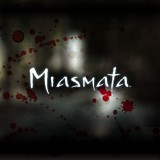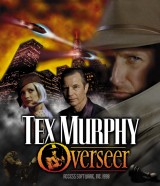Review for Argonus and the Gods of Stone
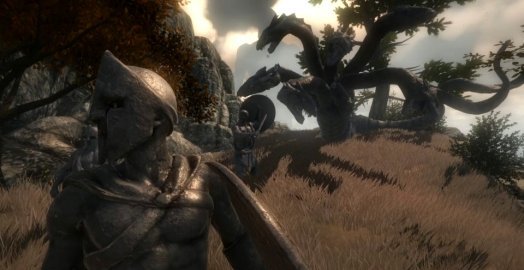
May this humble scribe be blessed by the Muse to recount the experiences of Argonus and the Gods of Stone, wherein dwell the great gods Athena, Poseidon and industrious Hephaestus. Indeed, this tale, like a fine tapestry, weaves together the elements of myths and legends old and new in exciting ways to present a classic adventure fit for the ages. Friends, Romans, countrymen, lend me your eyes as I delve into the sights, sounds and puzzles of Zojoi’s real-time first-person ancient Greek exploits.
Argonus is the son of the man who built the Argo, the ship that carried the legendary Jason and the Argonauts. As the story begins in 1242 B.C., Argonus is sailing aboard that selfsame ship when it comes under attack and the titular hero is dropped into the sea. There he is rescued by Athena and dragged ashore on a nearby island where the game proper begins. After watching the awesome march of a giant stone warrior overhead, Argonus ventures inland and discovers that not all is well, as both the populace and the other survivors from the attack on the Argo have been turned to stone.
As you explore the island and learn what befell its people, you will meet and become the champion of an assortment of Greek gods and goddesses, though Athena is the only one you meet in the flesh. All the rest are discovered in temples, each with a statue dedicated to one of the deities. Approaching said sculpture will cause it to come to life, imbued with the essence of the god or goddess it represents. As these statues tower well above Argonus, it’s an impressive sight that always grabbed me no matter how often it happened.
The island is also home to other denizens of Greek mythology, with such familiar staples as griffons, harpies and even the Minotaur all making an appearance. Most evocative for me, though, were the skeletal warriors who are helpful in some of the game’s puzzles. The developers have cited Ray Harryhausen’s Jason and the Argonauts film as one of their inspirations, a fact most apparent in the appearance and movement of these skeletons. While they lack the jerkiness of stop motion animation, their general hunting animations are eerily familiar.
When I first got into this game, I was a little unsure of what to expect. The trailers could easily have been for a swords and sandals movie instead, and I had some qualms that there’d be a high degree of action to deal with and a low degree of adventure. Those fears were laid to rest, however, as there is actually no action or timed playable sections. This is 100% adventure game through and through, with the action moments presented only in cinematic cut scenes throughout.
Argonus pulls no punches on its puzzles either. There’s not a lot of handholding done here. While not at the same level of difficulty as, say, Myst or Riven, there are some good head-scratchers to be found, often requiring information and items from across the islands to succeed. One such occasion is when having to drive off a flock of harpies through a complex series of seemingly disparate steps, the main clue for which requires its own challenge to be solved first.
Special care must be taken when talking to the gods. Each one gives Argonus a labour to perform and provide hints to varying degrees of what needs to be done to accomplish their tasks. However, each god can only be entreated once to receive the labour and will only speak again after that challenge is complete. This means it can be easy to miss or not understand the significance of what the gods have to say.
In the end, I had to consult a walkthrough for a couple of puzzles that weren’t particularly well clued, including one late in the game that requires you to revisit all the areas you’ve already seen to free the trapped souls in the statues on the island in order to progress. (You may want to keep notes on where those statues are as you find them.) I spent over an hour of my nine total hours of play time traipsing back and forth trying to find the last two statues I needed, which was rather frustrating to say the least. Some manner of item or artifact to sense when a statue was nearby would have been most welcome. (EDIT: Following a recent update, you no longer have to free all Argonauts, only about half of them, reducing this potential frustration considerably.)
Navigation is done via mouse and keyboard typical of first-person 3D games, or with the game controller, both of which work equally well. The island is not monstrously huge, but it’s large enough that you’ll find yourself running from place to place. Fortunately the game provides both a hold-to-run button and, even better, a toggle run option. As you wander about the island, little grey circles will pop up on distant things you can interact with. As you draw closer, they light up yellow and can be examined with a left-click and sometimes interacted with via a right-click. Most of the puzzles are inventory-based, so interactions largely consist either of picking items up or using already gathered objects by dragging them from an otherwise hidden side inventory onto one of the hotspot circles.
Being on an island, there is little variation in the locations visited. Several small villages dot the landscape with humble buildings built within. The temples are grander and made of stone and marble. Between these are diverse forms of wilderness, whether sandy beaches and roiling sea on the coast, tall windswept grasses, or denser wooded areas. These locales could have begun to feel very repetitive, especially as they’re all done in a drab, desaturated, almost sepia-toned palette, but surprisingly this is not the case. Good use of both positive and negative space has been made to make each area feel distinct, even though it may be constructed from the same basic building blocks as another region. A sparse forest twisting up a cliff side feels very different from the flat, almost cave-like path through thicker and more claustrophobic vegetation surrounding the temple of Hades.
One of the most iconic places you’ll visit is the Labyrinth. When I first discovered I’d have to delve inside, I was less than enthusiastic about the prospect. Fortunately, it’s a maze with a trick. At the entrance a small model of the maze can be manipulated, and the goal isn’t so much to find a way through the maze as to make one. The maze is laid out in concentric circles, and by rotating them on the model, the structure itself changes, moving various doorways around. I found it a clever way to incorporate the Minotaur’s Labyrinth of myth without the drudgery of an actual right-hand rule maze.
In fact, Argonus does a good job of incorporating a number of mythological elements. They mostly factor into the story events unfolding on the island as relayed by the gods, and can be as helpful or as vengeful, as honourable or as promiscuous as they are in actual legend. At the same time, the developers have done what all good storytellers have done with these myths through time: they’ve taken the various details and tweaked them to help tell a new and engaging tale.
The famed Muse of eloquence and epic poetry serves as the lone voice for the entire game, save for a particular number of optional comments from Argonus or when the gods themselves speak. Calliope provides everything from narration of the story to descriptions of simple household goods when examining items in the villages. The voice actress for Calliope is quite good, talking in slow, measured tones with a North American accent that is soothing to listen to. She’s also been given a fine script to work with, as the level of writing is excellent and highly evocative of the written myths on which it’s based. I found this to be the most enjoyable aspect of the experience, and I was continually compelled to learn more about who or what was responsible for petrifying the villages – and just as importantly, why. Without getting spoilery, the motivations of the “bad guys” are completely believable, especially in the context of the mythology from which they’re inspired.
The dulcet tones of Calliope are not the only audio accompaniment throughout the journey. Sound effects are also well done and a suitably mythical orchestral soundtrack underscores most of the adventure and adapts to new situations. It leans more towards the fantastical and adventurous when legendary creatures battle one another, soars with choral voices as you draw near to one of the temple gods, and withdraws nicely into the background when you’re just roaming about the island, taking in the sights. One element that particularly caught my attention was what seemed to be a simple ambient sound that was really a clue guiding me to an important area. So seldom is organic audio used to provide direction in games that it was nice to encounter one here.
The game has several nice user-friendly touches that contribute to a solid and enjoyable experience. Although many adventures nowadays eschew free-saving in favour of a single autosave, Argonus thankfully allows you to save anywhere. It also takes advantage of its loading screens. The island is divided into half a dozen areas with a quick loading screen between them. Instead of providing gameplay tips during the wait, these screens provide small snippets of backstory about Argonus and where he came from in chronological order. It was particularly fun when the story caught up to events from the game itself. It was cool to see Argonus’s exploits under your control related on the loading screens afterwards. (Don’t worry, the loading screens never pass the point in the game you’ve actually reached yourself.)
Another welcome feature is the in-game map that can be accessed at the press of a button. Rather than using it for quick travel, this map marks the sites of major puzzles once they’re completed. Clicking on these causes Argonus himself to share his thoughts on the labours he’s performed while stylish pencil drawings are sketched in to illustrate those challenges. These reflections are the only point in the game where you will hear Argonus’s voice, which is too bad as the actor provides a fine performance.
The narrative spans five acts called “books” here. Learning how and why the residents of the island were turned to stone is one of the great joys so I won’t spoil the details here. What I can say is that the game reaches its final climax in an interactive, after-credits epilogue thanks to a post-launch “Director’s Cut” update. Upon the game’s initial release, my biggest disappointment was that when nearing the end it just…stopped without proper resolution of any kind. Fortunately the developers took early feedback to heart, and the new addition pulls various elements of the story together in an emotional conclusion. Given the callous disregard and arbitrary way the gods use mortals, this last moment is particularly poignant.
Argonus and the Gods of Stone provides an interesting island locale to wander about and explore, uncovering an engrossing mystery filled with action and intrigue along the way. Various quality of life features make this a solid gameplay experience across the board, and while a couple of puzzles could be better clued, on balance it’s a fair but challenging puzzling experience. It has the fantastical elements of Greek mythology, the weight of antiquity, and is a really great adventure all around. The gods have smiled on this game.
WHERE CAN I DOWNLOAD Argonus and the Gods of Stone
Argonus and the Gods of Stone is available at:
We get a small commission from any game you buy through these links (except Steam).Our Verdict:
Argonus and the Gods of Stone takes elements of real Greek mythology and shuffles them about to create a fantastic, engrossing new experience that feels like it fits in antiquity.



